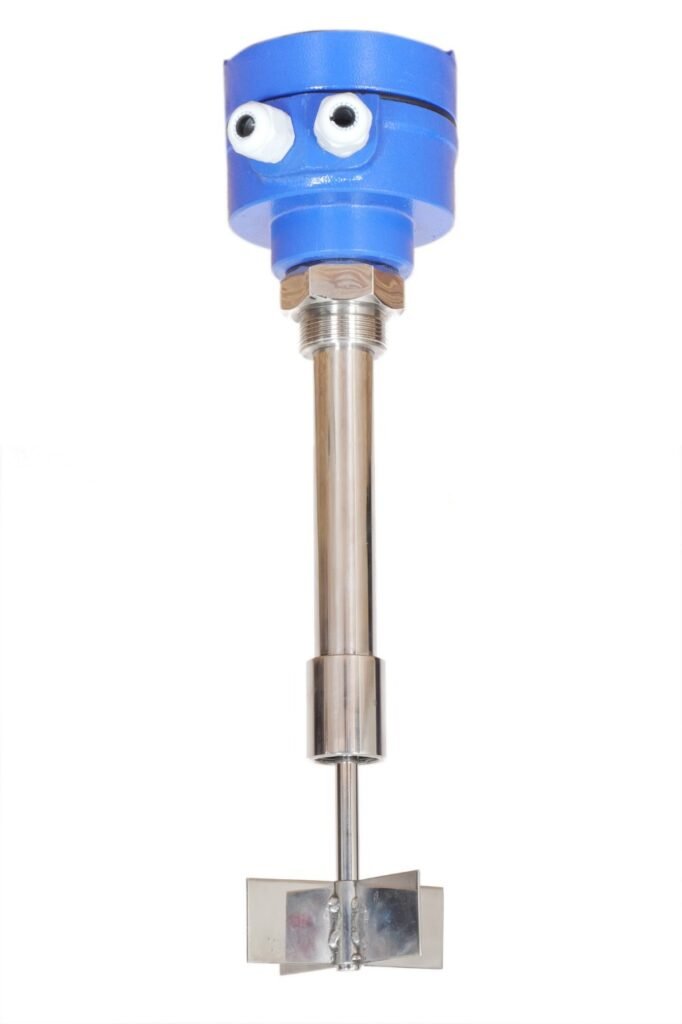This article dives into how rotating paddle level switches are revolutionizing process control, the tradeoffs between various level sensing technologies, and the importance of selecting the right switch based on the application’s unique needs.
What is a Rotating Paddle Level Switch?
A rotating paddle level switch is a mechanical level detection device commonly used in bulk solids handling. It features a motor-driven paddle that rotates freely until the material level interferes with it, triggering an alert or a control action. This switch is widely preferred for detecting low or high levels in bins, hoppers, or silos containing powders, granules, or other bulk materials.
The Role of Diaphragm Type Level Switches
While rotating paddle level switches are ideal for solid materials, diaphragm type level switches are typically used for liquid applications. These switches detect changes in pressure exerted by the material on a flexible diaphragm. When the pressure surpasses a certain threshold, the switch activates to indicate the presence or absence of material. Both technologies are pivotal in achieving optimal level control but cater to different industrial requirements.
Key Advantages of Rotating Paddle Level Switches
-
Cost-Effective: They offer a budget-friendly solution for solid level measurement.
-
Reliable Performance: Minimal false alarms and high accuracy in bulk material handling.
-
Low Maintenance: Simple mechanical design reduces the need for frequent servicing.
-
Versatility: Suitable for a wide range of materials and container sizes.
Challenges and Tradeoffs in Level Measurement
Despite their advantages, rotating paddle level switches and diaphragm type level switches come with certain tradeoffs:
-
Material Compatibility: Paddle switches are not suitable for liquids or sticky materials. Diaphragm switches can face issues with highly viscous or corrosive liquids.
-
Environmental Factors: High temperature or pressure may affect switch accuracy or longevity.
-
Installation Complexity: While paddle switches are easy to install in solids, diaphragm switches may require careful calibration and positioning in liquid systems.
To achieve optimal performance, businesses must carefully assess the nature of the material, process environment, and control requirements before choosing between these two technologies.
Industry Impact and Process Optimization
In the chemical and oil industries, precision level measurement ensures:
-
Avoidance of overflows or shortages
-
Improved safety protocols
-
Optimized material usage and reduced waste
-
Enhanced automation and process efficiency
As these industries continue to embrace automation and digital transformation, integrating reliable level switches like the rotating paddle level switch becomes crucial. They not only reduce manual intervention but also provide real-time data for better decision-making.
Environmental and Operational Considerations
Level measurement devices must operate reliably under harsh environmental conditions, including:
-
Dusty atmospheres
-
Corrosive vapors or fluids
-
High-vibration environments
Choosing between a rotating paddle level switch and a diaphragm type level switch depends on balancing these environmental challenges with operational needs.
Conclusion
Revolutionizing process control with rotating paddle level switches in the chemical and oil industries is no longer a futuristic concept it’s a necessity. These devices, along with diaphragm type level switches, offer robust, cost-effective, and accurate solutions that help industries stay competitive and compliant. However, the choice of technology must be guided by a deep understanding of material properties, environmental conditions, and application requirements.
FAQs
Q1. What is a rotating paddle level switch used for?
A rotating paddle level switch is mainly used for detecting levels of dry bulk materials such as powders, grains, or pellets in silos and hoppers.
Q2. How does a diaphragm type level switch work?
It uses a flexible diaphragm to sense pressure changes caused by the presence or absence of a liquid, triggering a switch to indicate level change.
Q3. Which industries benefit most from rotating paddle level switches?
Industries like chemical processing, oil and gas, cement, agriculture, and food processing benefit significantly from paddle level switches.
Q4. Can diaphragm type level switches be used for solids?
No, diaphragm type level switches are typically used for liquid applications due to their sensitivity to pressure changes.
Q5. What are the maintenance requirements for a rotating paddle level switch?
They require minimal maintenance due to their simple mechanical design but should be periodically checked for wear or blockage in dusty environments.







